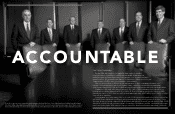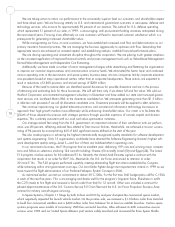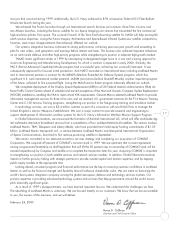Lockheed Martin 1999 Annual Report Download - page 15
Download and view the complete annual report
Please find page 15 of the 1999 Lockheed Martin annual report below. You can navigate through the pages in the report by either clicking on the pages listed below, or by using the keyword search tool below to find specific information within the annual report.
22
MANAGEMENT’S DISCUSSION AND ANALYSIS OF FINANCIAL CONDITION
AND RESULTS OF OPERATIONS
(Continued)
December 31, 1999
conditions to its closing. As a result, the Corporation now
owns approximately 49 percent of the outstanding common
stock of COMSAT and accounts for its investment under
the equity method of accounting. The total value of this
first phase of the transaction was $1.2 billion, and such
amount is included in investments in equity securities in
the December 31, 1999 Consolidated Balance Sheet.
The second phase of the transaction, which will result
in consummation of the Merger, is to be accomplished by
an exchange of one share of Lockheed Martin common
stock for each remaining share of COMSAT common stock.
Consummation of the Merger remains contingent upon the
satisfaction of certain conditions, including the enactment of
federal legislation necessary to remove existing restrictions
on the ownership of COMSAT voting stock. Legislation nec-
essary to remove these restrictions cleared the U.S. Senate
on July 1, 1999. On November 10, 1999, the U.S. House
of Representatives (the House) also passed legislation which,
if adopted into law, would remove these restrictions. There
are substantial differences between the two bills, and signifi-
cant issues raised by the House bill in particular which, if not
resolved satisfactorily, would likely have a Significant Adverse
Effect on COMSAT (as defined in the Merger Agreement).
The Corporation hopes these issues will be favorably resolved.
In early 2000, sponsors of the two different bills
announced a compromise agreement that, if adopted,
would resolve many of the issues raised by the House bill.
It is now expected that legislation that reflects the compro-
mise agreement will be enacted before May 2000. There is
no assurance that this legislation will be passed or passed in
this time frame, or that any legislation that does become
law would not have an adverse effect on COMSAT’s busi-
ness. If Congress enacts legislation that the Corporation
determines in good faith, after consultation with COMSAT,
would reasonably be expected to have a Significant Adverse
Effect on COMSAT’s business, the Corporation would have
the right to elect not to complete the Merger.
Before the Merger can occur, the Corporation must
file separate notification and report forms under the
Hart Scott-Rodino Antitrust Improvement Act (HSR Act)
with the Federal Trade Commission (FTC) and the U.S.
Department of Justice (DOJ) regarding its acquisition of
minority interests in two businesses held by COMSAT. In
addition, following the passage of legislation, the Federal
Communications Commission (FCC) must approve the
Merger. The precise nature of the FCC approval require-
ment will, however, depend upon the details of the final
legislation enacted by Congress. There is no assurance as
to the timing or whether the FTC, DOJ or FCC will provide
the requisite approvals. If the Merger is not completed on
or before September 18, 2000, under the terms of the
Merger Agreement, Lockheed Martin or COMSAT could
terminate the Merger Agreement or elect not to exercise
this right, or both parties could agree to extend this date. If
consummated, the Merger will be accounted for under the
purchase method of accounting. If the Merger is not con-
summated, the Corporation will not be able to achieve all
of its objectives with respect to the COMSAT transaction and
will be unable to exercise control over COMSAT.
The market value of the Corporation’s investment in
COMSAT at December 31, 1999 was approximately $515
million based on the closing price of its shares on the New
York Stock Exchange on that date. As noted previously,
completion of the Merger will require the exchange of one
share of the Corporation’s common stock for each remain-
ing share of COMSAT’s common stock. As a result, the
price of COMSAT’s common stock is closely aligned with
the price of Lockheed Martin’s common stock and may not
reflect the price at which COMSAT’s common stock might
trade absent the Merger Agreement.
Formation of Lockheed Martin Global Telecommunications
Effective January 1, 1999, investments in several existing
joint ventures and certain operating elements of the
Corporation were combined with Lockheed Martin Global
Telecommunications, Inc. (Global Telecommunications), a
wholly-owned subsidiary of the Corporation focused on
capturing a greater portion of the worldwide telecommuni-
cations services market. The Corporation intends to com-
bine the operations of Global Telecommunications and
























